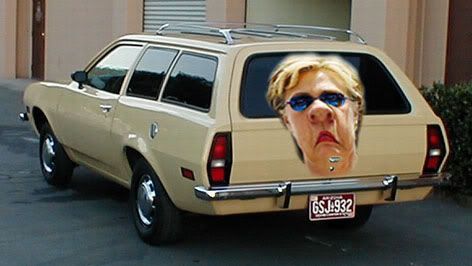I don't know about you but I would stay clear of the rear of this pinto.

Posted on 01/19/2007 6:14:25 AM PST by eraser2005
TOKYO (Reuters) -- Toyota Motor Corp. plans to recall about 533,000 Sequoia SUVs and Tundra pickup trucks in the United States to repair faulty components that could make the vehicles difficult to steer.
Six injuries and 11 accidents were reported as a result of the defect, Japan's top automaker said Friday.
(Excerpt) Read more at money.cnn.com ...
Oh, quick question on those GM trucks if you can recall - how many of them had 5.3L V8s, and how many had engine failures? (Not making a point in context here, actually just a bit curious as to how the CSK issue played out in a fleet like yours.)
My own personal dead horse in that respect is best illuminated by my Jeep.
A part fails on it. I go to the dealership and get a new one, as it is not available elsewhere. The new part fails in six months. Put another new part on, same thing happens. Replace entire subassembly in case it's the problem - same part breaks again six months later.
It doesn't matter what the actual part was, as almost all of them had the same pattern.
Contrast that with my now twenty year old Jaguar, which actually does have some aftermarket support, and if I do have to resort to a stealership, the part usually actually lasts at least as long as the original one did!
I don't know about you but I would stay clear of the rear of this pinto.

Ooooh, 1.25 million miles. Wow.
I have more than that spread over three Jaguars. I probably have a good 5 million miles in my logbook.
Please, do, list your GM vehicles.
Consumer Reports also listed the first year Hyundai Excel as a good car and just short of a Best Buy.
I stopped paying attention to them after that.
I don't know; I would have to go pull the sheets. They were the V8 that comes with the Z71 package --- albeit the Z71 package w/out the fancy graphics (e.g., skid plate, etc.)
5.3 sounds right.
They were an OK vehicle --- just had stupid things that would break --- door locks, A/C, whatever --- but they consistently had goofy issues that would keep a few in the shop at any one time.
The seats were a big complaints. Roughnecks are not small men, in general, and the seats sagged and looked/felt like hell in 3 months.
Ah, Consumer Reports of the "sorry we lied about the Trooper and the baby seats" fame.
In seriousness, most of the quality dings have to do with the consumer things (e.g., sat radio, CD player, door locks, whatever) that fleet trucks don't have.
All I can tell you about is my guys like them and they are not in the shop.
I have to agree on that, the seats in my friend's 2000 Silverado (fully loaded) were absolutely awful, and he wasn't using it for anything but commuting and light hauling.
Rumor has it that when Nissan went shopping for parts and designers for the Titan (since most of the major parts are made by the big 'names' like Bosch for the brakes, Rancho for the shocks, and Dana for the axles), they got Recaro to whip up a range of seat designs for the Titan. I tend to believe those rumors, as even the base seats in the Titan are extraordinarily comfortable.
As does the thousands in property taxes
And you can buy shares in Toyota if you want a share of the profits.
I guess all these Toyota worshippers haven't heard about the oil circulation problems on the v6 engines between 1997 and 2002. My friend's automotive shop has replaced many of these engines for his customers.
UAW?
I'd agree with you on the success of Toyota on leverage of a high quality product message. It makes good consumer marketing sense when considering such a large purchase. My cynicism over the Georgetown, KY plant story was really over how pervasive this 'religion' was beyond management layers. I may just take you up on your advice on Deming, lately my business reading has been focused on sales.
That was already mentioned above. VW, Ford, and Chrysler, among others, have had the same problem.
The VW ones are well documented.
Which Ford and Chrysler models are you referring to?
In 1954 Ford pioneered the ball-joint suspension; the original joints were made using a malleable iron socket and a machined steel ball fitted with grease fittings and dust boots and a recommended 3,000 mile/3 month lubrication schedule.
In 1957 Ford redesigned the assembly using stamped steel sockets as a cost-cutting move.
By the end of the year production on replacement ball joints for the 57 model had to be increased to keep up with demand; the entire 54-56 unsold replacement joints were scrapped beause they didn't wear out.
Read The Wastemakers (Vance Packard)just for fun. especially chapter six.
True, that is the same.
But a basic understanding of statistics and the failure rates that they report on will show that while they can't make conclusions with significant confidence on the difference between an average and an above average vehicle, they do have enough data to pick out the truly worst of the worst.
Disclaimer: Opinions posted on Free Republic are those of the individual posters and do not necessarily represent the opinion of Free Republic or its management. All materials posted herein are protected by copyright law and the exemption for fair use of copyrighted works.